In a bid to drive down tyre and wheel-related caravanning accidents, we’re asking caravanners to make a PACT for caravan tyre and wheel safety.
In this video we’re urging caravanners to use the word PACT to remember to carry out four simple checks on their tourer’s tyres and wheels to help prevent a tyre blow-out or wheel detachment.
Each year, at Caravan Guard we deal with a number of tyre or wheel-related caravanning claims, like tyre blow-outs, which can cause significant damage to your tourer, or worse still, a serious accident. A tyre blow-out can cause damage to the caravan wheel arch and floor, both externally and internally, and around the underside of the caravan, costing hundreds of pounds to repair.
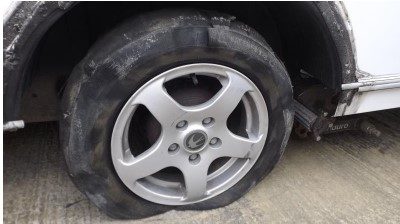
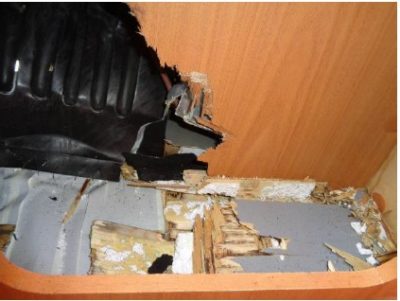
In more serious cases you could lose control of your caravan when towing, causing it to overturn or crash into something.
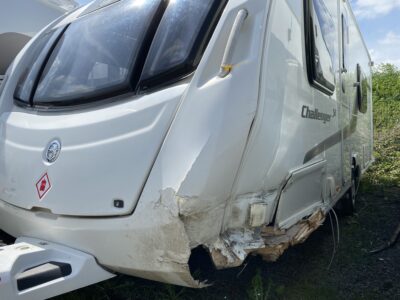
So, let’s make a PACT to keep you and other motorists safe on the road.
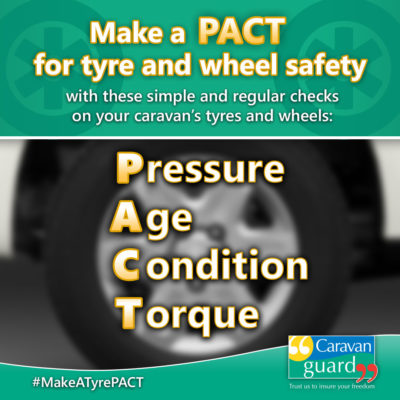
P = Pressure
Check your caravan tyre pressures regularly, ideally before each trip.
A correctly inflated tyre wears its tread evenly and gives the best grip on the road. Under inflated tyres cause uneven wear on the shoulders of the tread. Over inflation causes excessive wear in the middle of the tread pattern. In both cases, incorrect tyre pressures will cause uneven wear and shorten the lifespan of the tyre, as well as affect towing stability, braking distance, cornering and could cause a tyre blow out.
If you don’t know the correct pressures of your caravan’s tyres, check your caravan handbook or sometimes it’s on the side of your caravan.
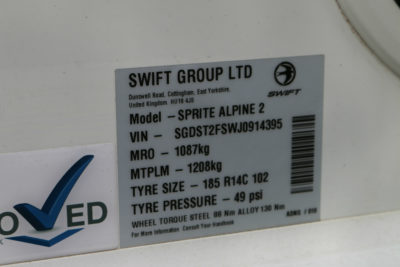
If you can’t find the correct pressures visit the TyreSafe website and use their online caravan pressure calculator. All you need to know is your tyre size and load index, for example 185 R14C 102, and the MTPLM of your caravan. All this information can be found by looking at the tyres and VIN plate of your caravan.
A = Age
Old tyres can be prone to blowouts. It’s a recommendation that tyres, which are five years or older should be replaced regardless of their condition.
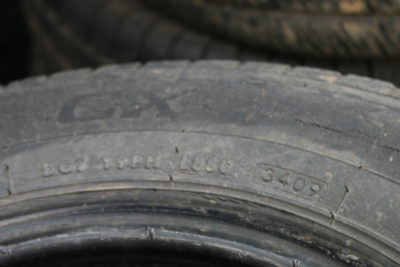
Tyres come with a date of manufacturer stamped on the sidewall. Look for D.O.T then four numbers. In this example 3409 means the tyre was manufactured on week 34 of 2009, and therefore should be replaced.
C = Condition
The condition of caravan tyres can deteriorate over time by things such as UV damage from the sun and standing still for long periods of time.
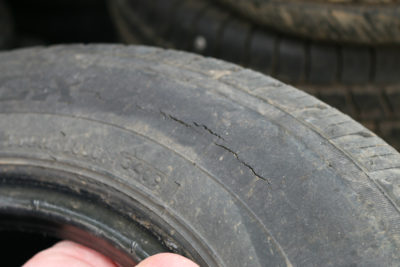
So, check the sidewalls of your caravan tyres for cracks, bulges, cuts or embedded materials. If you find any, replace them immediately.
It’s a good idea to regularly move your caravan wheels if you don’t use it often, or jack up your caravan and rotate the wheels, to make sure different parts of the tyres take its weight over time.
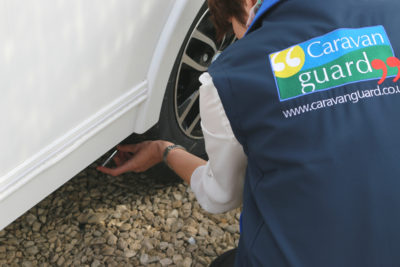
Check the tread for wear using an approved tread gauge. The tyre should have at least 1.6mm of tread over 75 per cent of the tyre surface on its entire circumference.
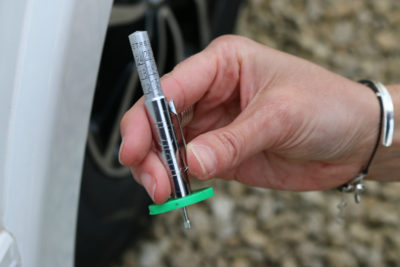
Check tread depth in several places of the tyre and look for cracks on the tread pattern. Again, if you find any cracks, replace the tyres immediately.
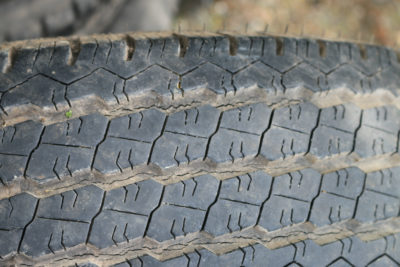
Don’t forget the spare!
In all cases, don’t forget to check your caravan’s spare tyre for its pressure, age and condition.
T = Torque
Caravan wheel detachments do happen. This could be from the wheel nuts being too loose, or by being over-tightened and causing damage to the wheel hub.
It’s important to check the wheel nut torque using a calibrated torque wrench. The correct torque value can be found on the side of your caravan.
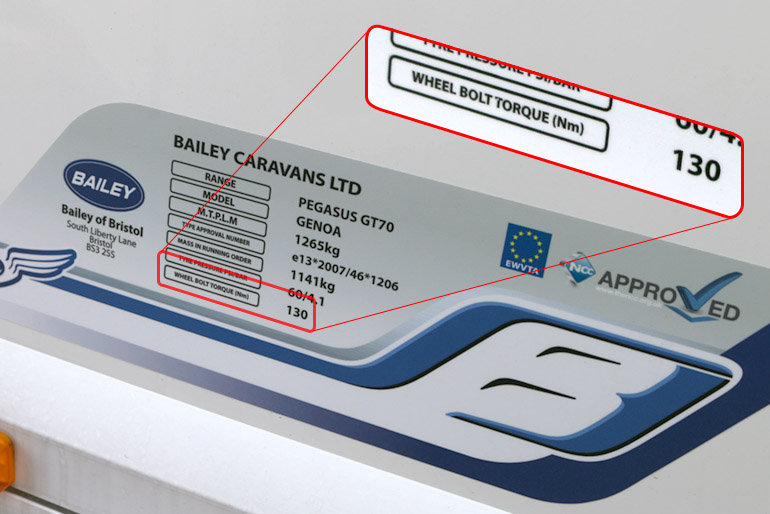
If you can’t find this value, contact a local caravan dealership who should have the information to hand.
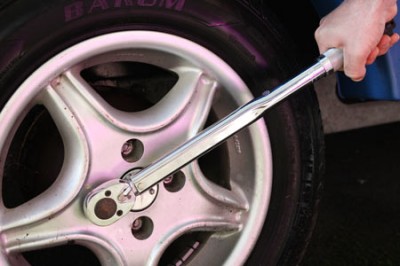
Check the torque in a star formation, and remember to loosen the torque wrench when finished.
Insurance discounts for tyre safety devices
As well as carrying out regular safety checks on your whole outfit’s tyres, it’s also worthwhile investing in a tyre pressure monitoring system (TPMS) for your caravan and/or Tyron safety bands to minimise the chances of a blowout.
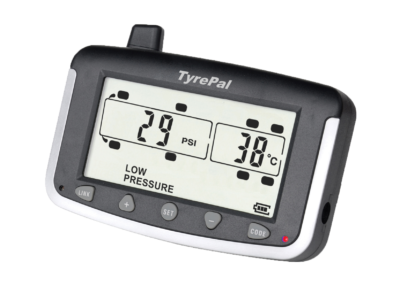
There are Tyre Pressure monitoring systems for caravan outfits which continuously monitor both the pressure and temperature of your car and caravan’s tyres when you’re driving – giving you an alert if things aren’t right.
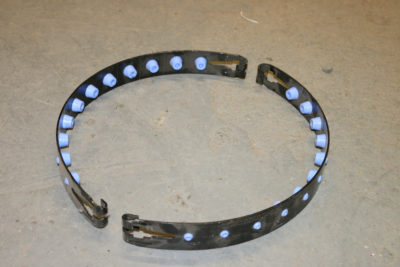
Tyron Safety bands fitted to a caravan’s tyres increase the stability of a caravan outfit in the event of a blowout – allowing the driver to safely pull the vehicle over to the side of the road.
Because of their safety features, we offer a discount on our caravan insurance premiums for caravanners who fit either Tyron bands or a tyre pressure monitoring system.
Over to you…
Do you carry out these simple checks on your caravan’s tyres and wheels before every trip? Are you ready to make a PACT for tyre and wheel safety? What do you make of the caravan tyre and wheel PACT?
We’d love to hear your comments in the box below. And don’t forget to like and share on our Facebook and Twitter pages using the hashtag #MakeATyrePACT!


I always do these checks before setting off, both going away and returning.
One thing that has happened to me was I had two new tyres fitted by by a well known car tyre fitting company, only when I came to replace them I found that they had fitted the wrong load speck for my caravan they were under rated, which could have been a problem if I had an accident I am sure the insurance company would not have paid out.
I was unaware that it was up to me to know what tyres should be fitted, I trusted the professionals how wrong I was.
Let this be a warning to everybody do your home work and trust no one!
Hi All,
I have been caravaning since 2012 and have always checked the tyre pressure/torque prior to travelling and returning. This gives me piece of mind as once you get on the busier roads especially motorways the damage caused by a puncture or wheel coming loose doesn’t bare thinking about, I think the information in this clip is extremely useful.
Very interesting and informative article, having lost a wheel, I only know too well the consequences of such an action; it is very frightening and extremely dangerous. I always check the torque each time I travel. I’m surprised at the number of caravaners who neither check the wheels or nose weight when leaving a site, this type of article is really helpful to all road users.
Thank you Peter 🙂
Thank you Liz. I will do that. I know that for £50 or so I could have a new tyre fitted but as a retired MOT tester, if the tyre was fitted to a vehicle that was presented for a test, it would be a “pass” because none of the “fail” criteria was evident, although perhaps an advisory based on the age of the tyre would be appropriate.
Have enjoyed reading P.A.C.T. And the comments. I will check my tyres now and change them if necessary.
SAFETY FIRST.
Good article, thanks.
I bought my 2005 Lunar Ariva second hand from the original owner three years ago. It was still on its original tyres so I immediately had them replaced. So far I haven’t replaced the spare because I know it has never been on the van and always stored in either a shed or garage out of the sun. I can see no evidence of any form of degradation. So my question is, what is the “shelf life” of a tyre that has never been used or exposed to the elements?
That’s a great question Grahame. The British Tyre Manufacturers’ Association say consumers should check tyres regularly for any sign of ageing, such as cracking / crazing of the tyre sidewall and or tread distortion and that vehicle manufacturers may recommend a specific age at which a tyre should be replaced. I would suggest that you seek advice from a specialist tyre fitter and ask them to examine the tyre for you.
In 2001, I had a puncture in a caravan tyre having just left a dual carriageway in the Dordogne region of France at the end of a 170 mile journey. We were on a road where I could actually see the campsite which was our destination for a holiday and I dread to think of what might have happened if this occurred on the dual carriageway!!
The caravan tyres were in their fifth season and so, following this incident I made it my policy to change them after four season’s use. I learnt that caravan tyre safety should be a priority meaning that the expense of new tyres is a sensible option.
I had a tyre which deflated on an overnight stop ,on way home from Cornwall,so had two new tyres fitted at what I thought was reputable company ,before continuing journey home,about six months later,caravan at home,surprised to see one tyre flat one half inflated,on checking
The valves were perished,,so Please make sure that tyre technicians,fit new valves every time new tyres are fitted,
very good article for what time it takes I check my torque settings before every j ourney
Hi my only argument with this is as an x MOT tester I’ve seen tyres on cars 10/12 years old low mileage cracked but no cores etc showing and you cant fell it, but a caravan is advised to change the tyres.
As a car is able to do 70 mph i think the advice should apply, or MOT caravans and stop all the arguments, and insurance saying we a not paying your tyres are above the required date to change that’s why you had a blowout .
Hi Michael, it’s difficult to compare car tyres with caravan tyres as they’re often stored in different ways and undergo different stresses. For example, caravans are often stored outside in the full sun for weeks or months without their wheels being turned. Changing your caravan tyres after five years is an accepted guide across the industry.
In terms of paying out for tyre blow out claims, here at Caravan Guard it’s unlikely we wouldn’t pay out on a claim based on the age of the tyre.
As well as the potential damage and cost, confidence in towing takes a beating.
Great safety on caravan wheels on tyres Good information P A C T hope people listen
Thanks for the feedback John. #MakeATyrePACT
Don’t forget the condition of the tyre valves. I once had a 3 year old bailey owned from new and serviced by Bailey appointed workshops,I checked tyre pressures before leaving home after about 3 miles noticed it was not towing correct L/H tyre pressure was down, on inspection tyre valve had perished with cracks and leaking. R/Hand and spare tyre valves were also cracked .
Good advice Stephen. Thanks for sharing.
the five year tyre rule has now been changed to seven. NCCC
Thanks Tony, it’s not a five year rule it’s simply a recommendation to change your tyres from five years of manufacture. They should only ever be used for a maximum of seven years.
Excellent article on tyre safety.
Keep these routine maintenance notices coming…They are invaluable.